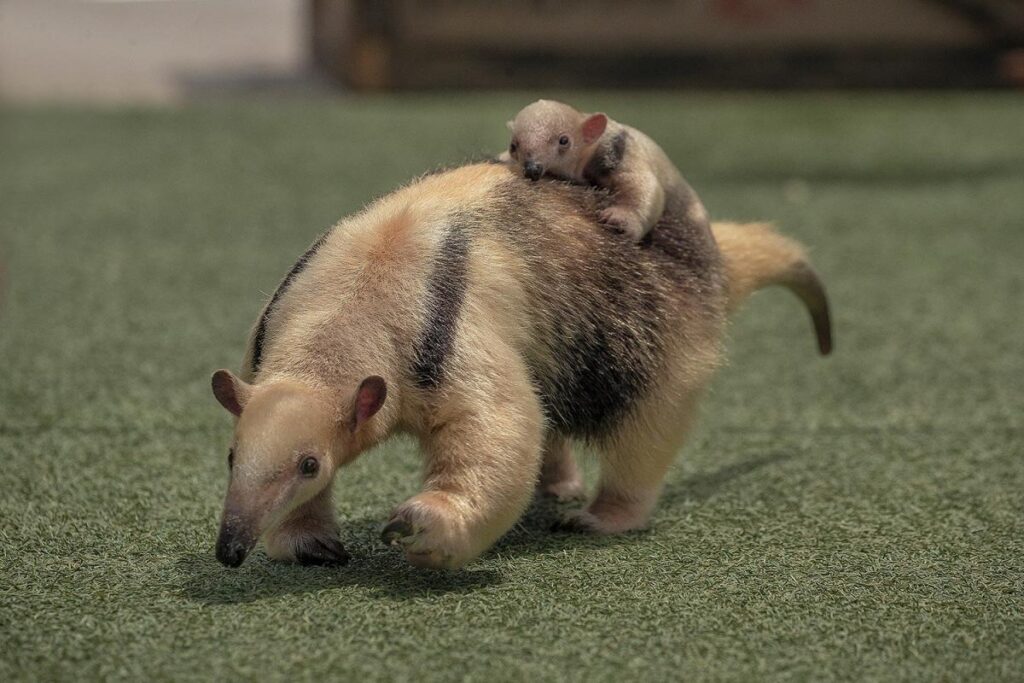Table of Contents
ToggleIntroduction
Tamanduas, commonly known as lesser anteaters, are intriguing and unique mammals belonging to the suborder Vermilingua within the order Pilosa. These fascinating creatures are renowned for their distinctive appearance, intriguing behavior, and ecological significance.
As part of the anteater family, Tamanduas are closely related to their larger cousins, the giant anteaters. They share some remarkable adaptations that have enabled survival in diverse habitats across Central and South America.
Physical Characteristics
Tamanduas exhibit a remarkable range of sizes and physical features, distinguishing them from other mammals. Their adaptations are finely tuned for their arboreal lifestyle and insectivorous diet.
Size and Weight Variability
Tamanduas display sexual dimorphism, with males generally being larger than females. Adult Northern Tamanduas can measure between 50 to 90 cm (20 to 35 inches) in length, excluding their prehensile tail, which adds 40 to 65 cm (16 to 26 inches).
Body Structure and Posture
Tamanduas have a distinct body structure that aids their arboreal lifestyle. Their elongated bodies are well-suited for climbing trees, with solid forelimbs and sharp, curved claws that facilitate gripping onto branches. The tail, which is hairless on the ventral side, acts as an additional limb for stability and balance during climbing.
Fur and Coloration
Tamanduas possess short, coarse fur, mainly black, with a characteristic “vest” pattern of white or pale coat on their chest. This vest-like pattern provides camouflage in the dappled light of the forest canopy.
Habitat And Distribution Of Tamanduas
The habitat and distribution of tamanduas play a pivotal role in shaping their behavior, diet, and survival strategies. This chapter delves into the diverse ecosystems they inhabit and how their adaptations are finely tuned to these environments, highlighting their significance within the intricate web of life.
Natural Range of Tamanduas
Tamanduas are native to the Americas, spanning both Central and South America. Their range covers habitats from dense rainforests to more open grasslands and urban areas.
1. Northern Tamandua (Tamandua mexicana)
The Northern Tamandua’s range extends from southern Mexico down to parts of Nicaragua and Honduras. It inhabits various environments, including tropical and subtropical forests, deciduous woodlands, and human-altered landscapes.
2. Southern Tamandua (Tamandua tetradactyla)
The Southern Tamandua is found in a broader swath of South America, from Venezuela and Colombia to northern Argentina. It is adaptable to various habitats, including tropical rainforests, savannas, grasslands, and secondary forests.
Preferred Habitats and Ecosystems
Tamanduas have evolved to thrive in diverse habitats, reflecting their capacity to adapt to different ecological niches.
Rainforests: Both species of tamanduas are frequently found in tropical rainforests. Their prehensile tails, sharp claws, and specialized tongue make them well-suited for navigating the intricate tree canopies and seeking insect prey.
Savannas and Grasslands: Southern tamanduas inhabit more open environments, such as savannas and grasslands. Their ability to climb trees is essential for survival in these areas where trees might be more scattered.
Urban Areas: Tamanduas have also demonstrated an ability to adapt to human-altered landscapes, including urban areas. Their diet of insects can sometimes bring them into gardens, parks, and even agricultural fields where they can help control pest populations.
Role in the Ecosystem
Tamanduas play a crucial role in maintaining the balance of their ecosystems due to their dietary preferences and behavior.
1. Insect Control
The primary diet of tamanduas consists of ants and termites, which can sometimes become pests. Tamanduas help control their populations by consuming these insects, affecting the ecosystem’s health.
2. Seed Dispersal
Tamanduas may inadvertently aid in seed dispersal as they move through their habitats. Seeds from the fruits they consume can be deposited in different areas, contributing to plant diversity and ecosystem regeneration.
3. Prey for Predators
Tamanduas are an important prey species for various predators, such as jaguars, giant snakes, and birds of prey. Their presence in the food chain helps support the diverse species within their ecosystems.
Interactions With Humans
Tamanduas’ interactions with humans are multifaceted and intriguing, ranging from cultural significance to economic contributions and occasional conflicts. This chapter delves into the complex relationship between tamanduas and humans, exploring their roles in folklore, their impact on local economies, and the challenges posed by their presence in human-dominated landscapes.
Cultural Significance and Folklore
Throughout history, tamanduas have captured various cultures’ imaginations and become symbolic figures in folklore and mythology.
1. Indigenous Beliefs
In many indigenous cultures, tamanduas hold spiritual significance. They are often associated with traits such as strength, resilience, and adaptability, embodying qualities admired by these communities.
2. Myths and Legends
Tamanduas have been featured in myths and stories across different cultures. In some tales, they are portrayed as clever and cunning creatures that outsmart other animals, while in others, they serve as symbols of protection or are believed to possess mystical powers.
3. Art and Symbolism
Tamanduas have inspired artistic expressions in traditional art, crafts, and even contemporary works. Their unique appearance and behaviors have made them captivating subjects for artists and storytellers.
Conclusion
As we conclude our exploration of tamanduas and their captivating world, we reflect on the knowledge gained, the challenges faced, and the promising pathways for their conservation and coexistence. This final chapter underscores the importance of ongoing efforts to protect these unique creatures and their habitats while also highlighting the broader significance of their study in the context of biodiversity and ecosystem health.







